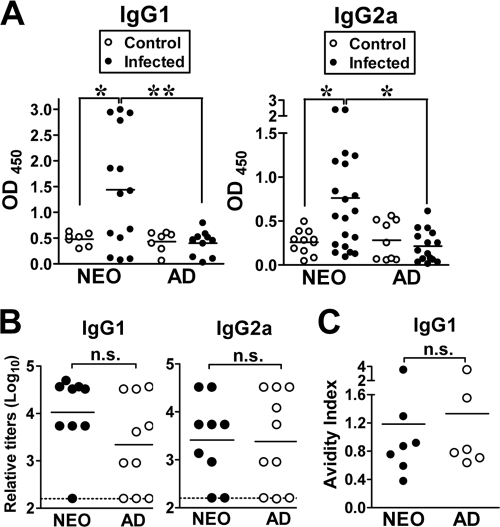FIG. 3.
Infection of neonatal mice with Y. enterocolitica leads to development of greater primary Yersinia-specific serum antibody responses and to secondary antibody responses similar in quantity and quality to adult responses. (A to C) BALB/c neonates and adults were infected orogastrically with 2 × 105 CFU of Y. enterocolitica. (A) Serum levels of Yersinia-specific IgG1 and IgG2a antibodies using purified MBP-LcrV were measured at 19 to 20 days p.i. from individual uninfected (○) and infected (•) neonates and adults using serum samples diluted 1/150. OD450 values are shown in the graphs (n = 7 to 11 controls and 11 to 20 infected mice). In the experiments shown in panels B and C, mice initially infected as neonates (NEO) or adults (AD) were boosted orogastrically at 9 to 11 weeks p.i. with 5 × 106 CFU of Y. enterocolitica, and sera were collected at 21 days postboost and serially diluted. (B) The relative levels of IgG1 and IgG2a for 9 neonates (•) and 10 adults (○) were pooled for analysis from two independent experiments. Undetectable antibody titers were plotted at the dashed line. (C) The avidity of memory IgG1 antibodies to LcrV for 7 neonates and 6 adults was tested in a serum ELISA using increasing amounts of KSCN (0.1 to 3.5 M). The amount of KSCN that reduced the OD450 by 50% is defined as the avidity index. Differences were calculated by the Mann-Whitney test. n.s., not significant; *, P ≤ 0.03; **, P = 0.007.

